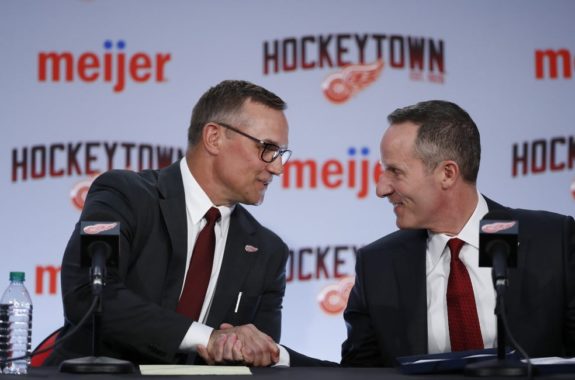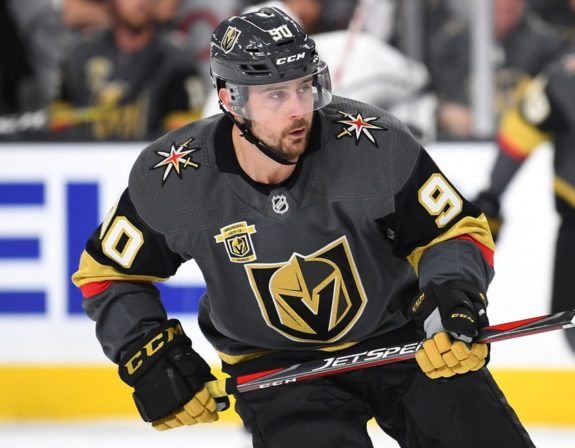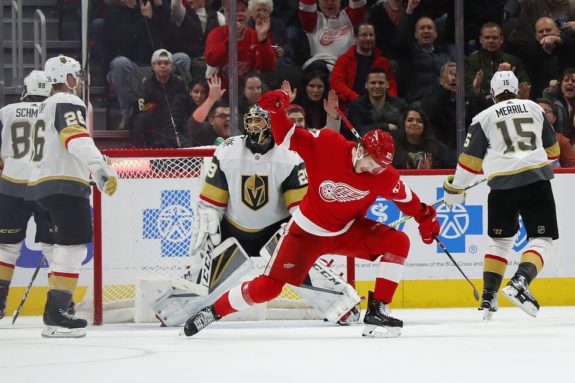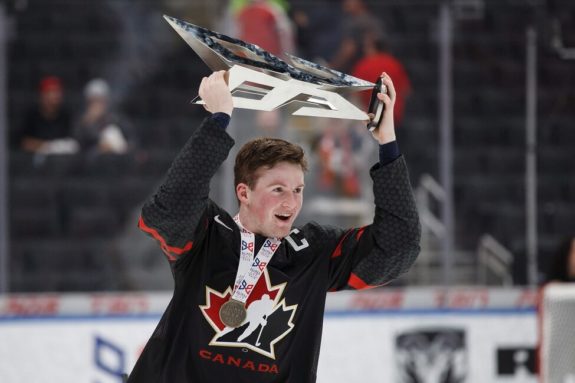The Detroit Red Wings officially began their rebuild during the 2016-17 season when hopes of a 26th-consecutive playoff appearance were dashed. Then-general manager Ken Holland kicked off the process by selling at the deadline, moving a handful of players for picks and prospects.
Since then, Holland and Steve Yzerman have led the organization through a couple of trying seasons and drafts, pulling strings along the way in an attempt to improve Detroit’s future. The fruits of their labor are becoming evident, but there’s still work to be done if the Red Wings are going to return to contention.

Yzerman stressed patience in his introductory press conference. It was certainly a clear theme when he walked away from his first draft as the Red Wings’ GM. And it was also evident when analyzing Detroit’s moves during free agency this summer.
But how much patience should Red Wings fans have? Arguably, the team hasn’t been competitive since the lockout-shortened 2012-13 season, when the Red Wings came within a single goal of reaching the Western Conference Finals.
Let’s take a look at the state of Detroit’s rebuild. Are Holland and—to a lesser degree— Yzerman’s moves paying off? Are the prospects they selected developing into NHL contributors? And how are those who have reached the NHL progressing in their own individual development? Check out the answers to those questions and more below.
Related: Red Wings: Predicting Moritz Seider’s 2019-20 Team
Trading Away and Acquiring Assets
Generally speaking, the roster management task most closely associated with a rebuild is trading away players on expiring contracts for picks and prospects. Moving other players deemed not essential to the future would also fit the bill.
Since the 2017 NHL Trade Deadline, Holland and Yzerman have traded 12 roster players for a slew of prospects and draft picks. The deal that sent Tomas Tatar to the Vegas Golden Knights certainly stands out as the highest profile trade of the bunch.
- RW Tomas Jurco – Pending RFA and unlikely to be retained
- D Brendan Smith – Pending UFA and out of Detroit’s price range
- LW Thomas Vanek – Pending UFA
- LW Steve Ott – Pending UFA
- C Riley Sheahan – Pending RFA and out of Detroit’s price range
- D Ryan Sproul – Had fallen on the depth chart
- LW Scott Wilson – Pending RFA and unlikely to be retained
- G Petr Mrazek – Pending RFA and out of Detroit’s price range
- LW Tomas Tatar – Had a large cap hit and high trade value
- D Robbie Russo – Had fallen on the depth chart
- D Nick Jensen – Pending UFA and high trade value
- RW Gustav Nyquist – Pending UFA, out of Detroit’s price range, and high trade value
- 2020 fourth-round pick
Of those who were sent packing, only Tatar and Nick Jensen could have had a future in Detroit. However, both players would have been on the wrong side of 30 once the team ideally returns to contention. Holland opting to trade them was the right move, albeit a painful one after the organization that drafted and developed the duo into valuable NHL contributors.

For Gustav Nyquist, his situation was a little different from that of Tatar or Jensen. As a pending UFA, he couldn’t come to terms with the Red Wings on a new contract and was subsequently traded. It was the same case for Brendan Smith, who wanted—and at the time deserved—more than the Red Wings were willing to pay.
In return, the Red Wings acquired a total of 18 assets:
- D Madison Bowey
- D Dylan McIlrath
- LW Matt Puempel
- LW Adam Erne
- 2017 third-round pick – G Keith Petruzzelli
- 2017 third-round pick – C Zach Gallant
- 2017 third-round pick – D Kasper Kotkansalo
- 2018 first-round pick – C Joe Veleno
- 2018 second-round pick – RW Jonatan Berggren
- 2018 third-round pick – D Seth Barton
- 2018 third-round pick – G Jesper Eliasson
- 2019 second-round pick – C Robert Mastrosimone
- 2019 second-round pick – D Albert Johansson
- 2019 sixth-round pick – D Gustav Berglund
- 2019 seventh-round pick – G Carter Gylander
- 2020 second-round pick
- 2020 third-round pick
- 2021 third-round pick
Overall, the combined return in these trades isn’t earth-shattering. Joe Veleno is clearly the best of the bunch, with Jonatan Berggren, Robert Mastrosimone, and Albert Johansson in the next tier down. Otherwise, you have fringe NHL players at best and a few more selections to make.
Unfortunately for the Red Wings, the players they traded away were not superstars by any means. The package Vegas sent for Tatar was fantastic, but when you look at a team like the New York Rangers, they were able to complete similar deals on multiple occasions (Ryan McDonagh/J.T. Miller, Mats Zuccarello, Kevin Hayes). It’s hard to add top-tier prospects when you’re not trading top-tier talent.
Related: The Grind Line: More Red Wings Offseason Moves?
Red Wings’ Draft Results
When looking at Detroit’s first- and second-round draft picks since the rebuild began, there are certainly some building blocks, including a couple of cornerstone players.
- C Michael Rasmussen (2017)
- D Gustav Lindstrom (2017)
- RW Filip Zadina (2018)
- D Jared McIsaac (2018)
- D Moritz Seider (2019)
- D Antti Tuomisto (2019)
When you add in Veleno, Berggren, Mastrosimone, and Johansson, Detroit’s future has promise. However, they’re still missing a game-breaker or two needed to successfully challenge for the Stanley Cup.
In his annual analysis of Detroit’s prospect pipeline, The Athletic’s Corey Pronman echoed Yzerman’s sentiment about patience:
“The Wings have a lot of very good players on the way but still look to be in the early parts of their rebuild.”
–Corey Pronman (from ‘2019 NHL farm system rankings: No. 13 Detroit Red Wings’ – The Athletic NHL – 8/22/19)
Despite picking further back in the draft than expected, the Red Wings were still able to land quality players in Zadina and Seider. However, there are also some missed opportunities.
Going back to the 2017 draft, you have to wonder what Martin Necas could have done in the Red Wings organization had he been chosen over Rasmussen. The same could be said about Jason Robertson, Jaret Anderson-Dolan, Alex Formenton, and Maxime Comtois, who were all chosen after Lindstrom despite being ranked higher by much of the scouting community.

Hindsight is unfair lense to judge the Red Wings, though. And there’s plenty of time for Rasmussen and Lindstrom to develop into impact NHL players.
But considering the prospects already in the system, the Red Wings need one, maybe two more drafts (and some luck) to add the necessary components to be a true contender. That’s just where they’re at right now with regard to their draft performance over the past few seasons.
Related: Red Wings Prospect Rankings: Summer 2019
Development of Detroit’s Young Core
This past season, Dylan Larkin, Anthony Mantha, Andreas Athanasiou, and Tyler Bertuzzi all took enormous strides with their development. Factoring in the 2019 World Championships, Filip Hronek could be included in that list as well.
But looking at just the 2018-19 NHL season, Detroit’s 24-and-under players stepped up in a big way. Offensively, they’ve completely taken over from the old guard, especially when you consider their production over the past two seasons:
| 24-and-Under Production | 2017-18 | 2018-19 |
| TOI % | 26.14% | 43.56% |
| Goals % | 35.85% | 61.61% |
| Goals/Game | 0.93 | 1.68 |
If Cholowski, Rasmussen, Zadina, and Evgeny Svechnikov can take another step forward in their development, these numbers will look even better this time next year.
Related: Red Wings Rebuild: Grading the Young Guns
Projecting the 2021-22 Red Wings Roster
When the 2021-22 campaign rolls around, it will be about five years since the rebuild kicked off. Ideally, the Red Wings should be on the rise and, at the very least, be able to compete for a playoff spot.
Based on the moves they’ve made so far, here’s how their roster could shake out in a couple years. Note that future draft picks are not included in the roster projection, but will be discussed later on.
| LW | C | RW |
| Anthony Mantha | Dylan Larkin | Filip Zadina |
| Andreas Athanasiou | Michael Rasmussen | Tyler Bertuzzi |
| Taro Hirose | Joe Veleno | Evgeny Svechnikov |
| Christoffer Ehn | Frans Nielsen | Adam Erne |
| Justin Abdelkader | Chase Pearson |
| LD | RD | G |
| Danny DeKeyser | Filip Hronek | Filip Larsson |
| Dennis Cholowski | Oliwer Kaski | Kaden Fulcher |
| Madison Bowey | Moritz Seider | |
| Gustav Lindstrom |
Chances are, the Red Wings will have another top-ten selection in the draft next spring who could conceivably be part of the 2021-22. Best-case scenario, it’s Alexis Lafreniere, who torched the QMJHL as a 16-year-old. The likely first-overall pick in the 2020 NHL Draft will make the jump to the NHL immediately.
But excluding Lafreniere or whoever the Red Wings draft, the 2021-22 roster still has some punch to it. Brace yourselves, though. The word “should” will appear frequently in this next section. And that always comes with the disclaimer that no one can predict the future with 100 percent certainty.
By 2021, Zadina should be a dynamic threat alongside Larkin on Detroit’s top line. Rasmussen should be a consistent performer at five-on-five. The Red Wings should have parted ways with a few veterans who currently occupy a tremendous amount of salary cap space.

In an ideal world, this is a solid team capable of making the playoffs. But Stanley Cup contender? Not yet.
Throw in Lafreniere, Lucas Raymond, Quinton Byfield, or Alexander Holtz, a middle-six center, and a solid goalie? Then you’re a little closer to contender status.
Final Word
The Red Wings should be able to add a couple more picks and prospects during the 2019-20 season. Mike Green, Trevor Daley, Jonathan Ericsson, and Jimmy Howard are all slated to become UFAs – Green and Howard should attract some attention.
There’s still work to be done in the rebuild. Patience is key, though. In the meantime, enjoy watching Detroit’s young players develop over the next couple of seasons – they’ll be an exciting group soon.